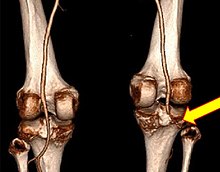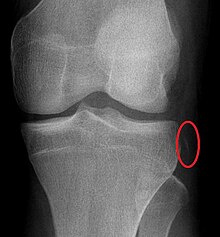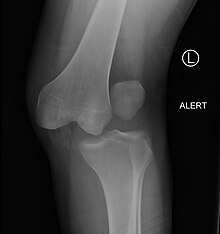Knee dislocation
| Knee dislocation | |
|---|---|
ACL tear[6] | |
| Treatment | Reduction, splinting, surgery[4] |
| Prognosis | 10% risk of amputation[4] |
| Frequency | 1 per 100,000 per year[3] |
A knee dislocation is an
About half of cases are the result of
If the joint remains dislocated,
Knee dislocations are rare, occurring in about 1 per 100,000 people per year.[3] Males are more often affected than females.[2] Younger adults are most often affected.[2] Descriptions of this injury date back to at least 20 BC by Meges of Sidon.[9]
Signs and symptoms

Symptoms include knee pain.[2] The joint may also have lost its normal shape and contour.[2] A joint effusion may, or may not, be present.[2]
Complications
Complications may include injury to the
Cause
About half are the result of
Minor trauma may include tripping while walking or while playing sports.[2] Risk factors include obesity.[2]
The condition may also occur in a number of genetic disorders such as
Diagnosis

As the injury may have self-reduced before arrival at hospital, the diagnosis may not be readily apparent.
Plain X-rays, CT scan,
If the
Classification

They may be divided into five types: anterior, posterior, lateral, medial, and rotatory.[4] This classification is based on the movement of the tibia with respect to the femur.[11] Anterior dislocations, followed by posterior, are the most common.[2] They may also be classified on the basis of which ligaments are injured.[2]
Treatment
Initial management is often based on
In those with signs of arterial injury, immediate surgery is generally carried out.[3] If the joint does not stay reduced external fixation may be needed.[2] If the nerves and artery are intact the ligaments may be repaired after a few days.[11] Multiple surgeries may be required.[4] In just over 10% of cases an amputation of part of the leg is required.[4]
Epidemiology
Knee dislocations are rare: they represent about 1 in 5,000 orthopedic injuries,[5] and about 1 knee dislocation occurs annually per 100,000 people.[3] Males are more often affected than females, and young adults the most often.[2]
References
- PMID 20411095.
- ^ S2CID 10713473.
- ^ S2CID 3482099.
- ^ ISBN 978-1-4377-1503-3.
- ^ PMID 26410637.
- ISBN 978-1455725021.
- PMID 24554457.
- ^ PMID 28324353.
- ISBN 9781449985219.
- PMID 28246569.
- ^ ISBN 978-0-323-35479-0.
- ISBN 978-0-323-29494-2.
